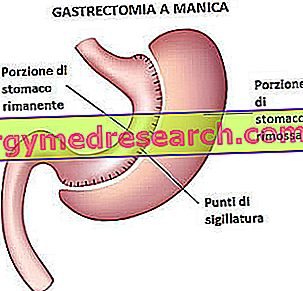Generality
Gastrectomy is the surgical operation to remove the stomach or part of it.
Performed with a traditional surgical procedure or laparoscopy, gastrectomy is essential for the treatment of stomach cancer and could also be useful in cases of obesity.
There are several types of gastrectomy: total, partial, sleeve and with esophagus removal.
After the operation, the patient remains hospitalized for 1-2 weeks and is required to radically change the way he eats.
If the gastrectomy is performed at the appropriate time and if the doctor's instructions are followed, the results of the operation can be positive.
What is gastrectomy?
Gastrectomy is the surgical procedure aimed at removing the stomach or a part of it.
ANATOMICAL BRIEF RECALL ON THE DIGESTIVE APPARATUS

Located between the esophagus and small intestine (or small intestine ), it is separated from the first by a valve called cardias and the second by a valve called pylorus .
MAIN TYPES OF GASTRECTOMY
Depending on the amount of stomach removed, the gastrectomy takes on a different specific name, which refers to the portion of organ removed.
Therefore, the following types of gastrectomy exist:
- Total gastrectomy, by which the surgeon eliminates the entire stomach.
- Partial gastrectomy, by which the surgeon eliminates the lower part of the stomach.
- The sleeve gastrectomy, by which the surgeon eliminates the left side of the stomach.
- Esophagogastrectomy, by which the surgeon removes the upper part of the stomach and part of the esophagus.
When you run
Gastrectomy is practiced mainly in the event of malignant stomach cancer (or stomach cancer ), but may also be necessary in the presence of obesity (see bariatric surgery), esophageal cancer, severe stomach ulcers and benign stomach tumors .
MALICNO CANCER AT THE STOMACH
Malignant tumors in the stomach are severe, very metastasizing neoplasms that are difficult to cure with chemotherapy and / or radiotherapy.
Therefore, they almost always require surgical removal of the entire diseased organ (total gastrectomy).
The rare cases of stomach cancer treated by partial gastrectomy are explained by the fact that the malignant tumor mass has formed in the lower part of the stomach and has not yet extended elsewhere.
SERIOUS OBESITY?
The gastrectomy intervention - and precisely of sleeve gastrectomy - is essential to cure obesity when
- this morbid condition seriously endangers who is affected;
- all possible non-invasive treatments have been tried without success.
By removing a section of the stomach, you want to reduce the amount of food that an individual can introduce with a meal.
ESOFAGO CANCER
Esophageal tumors, located between the esophagus and the stomach, are usually treated by an esophagogastrectomy.
GASTRIC ULCER
Today, the treatment of gastric ulcers is almost always of a pharmacological type.
However, in some rare cases the drugs are not very effective and, with the progressive worsening of the state of health of the stomach, gastrectomy is necessary.
BENIGNO CANCER AT THE STOMACH
Benign stomach tumors require partial or total gastrectomy for precautionary reasons. In fact, a benign stomach tumor could have a fair chance of turning into a malignant stomach tumor.
Risks and complications
Like any surgical operation, gastrectomy can lead to complications, in this case:
- Internal bleeding
- Infections
- Formation of blood clots in the veins
- Stroke or heart attack during the operation
- Allergic reaction to anesthetic drugs or sedatives used during surgery
Furthermore, since it affects a delicate structure of vital importance like the stomach, there is the risk of:
- Reduction of vitamin absorption capacity . Many types of vitamins - in particular vitamin B12 and fat-soluble vitamins - are absorbed by food also thanks to the activity of the stomach. Clearly, the complete removal of the stomach causes this absorption to fail. The absence or strong deficiency of these vitamins can cause:
- Anemia, since vitamin B12 is essential for the production of blood cells.
- Vulnerability to infections, since vitamin C is a fundamental element to strengthen the immune system.
- Bone weakening and, in the most severe cases, osteoporosis, since vitamin D is essential for good bone health.
- Pathological drop in body weight . It is dangerous for cancer cases and it is due to the fact that the patient feels full after even a small meal, therefore he does not eat enough.
- Rapid emptying syndrome . Lacking the stomach or a good part of it, the ingested foods arrive in the intestine only partially digested. This has several consequences, including hypotension, nausea, vomiting, abdominal cramps and abdominal bloating.
- Episodes of morning vomiting .
- Diarrhea .
- Acid reflux, typical of sleeve gastrectomy.
- Bowel obstruction . It is a characteristic complication of gastrectomy interventions for the treatment of malignant tumors.
- Losses (of food) where the resection of the stomach occurred, although these points were suitably sutured and sealed.
Preparation
Gastrectomy is a surgical procedure that involves general anesthesia . Therefore, before its execution, the individual must be subjected to the following clinical controls:
- Accurate physical examination
- Complete blood analysis
- Electrocardiogram
- Evaluation of clinical history (diseases suffered in the past, possible allergies to anesthetic drugs, medicines taken at the time of checks, etc.).
If there are no contraindications of any kind, the operating surgeon (or a member of his staff) will explain the methods of intervention, the possible risks, the pre- and post-operative recommendations and, finally, the recovery times.
Main pre- and post-operative recommendations:
- Before the gastrectomy, suspend any treatment based on antiplatelet agents (aspirin), anticoagulants (warfarin) and anti-inflammatory drugs (NSAIDs), because these drugs, by reducing the coagulation capacity of the blood, predispose to severe bleeding.
- On the day of the procedure, appear at full fast since at least the previous evening.
- After the surgery, be assisted by a trusted person .
Procedure
Gastrectomy can be performed with a traditional surgery (also called " open-air") or with a laparoscopic surgery (or laparoscopy operation ).
In the first case, the surgeon makes an incision of several centimeters at the level of the abdomen and, from the opening thus created, extracts all or only part of the sick stomach; in the second case, instead, it carries out (always on the abdomen) three small incisions of about one centimeter, through which it introduces the surgical instrumentation (laparoscope etc.) and extracts the sick stomach.
Obviously, both traditional and laparoscopic surgery allow the removal of all tissues (lymph nodes, neighboring organs, etc.) affected by primary cancer.
| Comparison between traditional gastrectomy and laparoscopic gastrectomy | ||
| Traditional gastrectomy | Laparoscopic gastrectomy | |
| Advantages |
|
|
| Disadvantages |
|
|
TOTAL GATRECTOMY
Total removal of the stomach requires the connection of the esophagus to the small intestine, so as to recreate a passageway for the ingested food. The connection requires the application of a sort of sutures, which, in the most unfortunate cases, could not completely seal the two digestive compartments and give rise to complications (loss of food).

From the site: digestive-motility.com
PARTIAL GASTRECTOMY
The partial removal of the stomach, precisely from its lower part, requires the connection of what remains (the upper part) with the small intestine. As in the previous case, the sealing could be deficient and give rise to food losses from digestive compartments not joined in a natural way.
GASTRECTOMIA A MANICA
During a sleeve gastrectomy, the surgeon removes the left side of the stomach - in particular the so-called "bottom" and most of the region called "body" - and the sealing of what remains.

Figure: sleeve gastrectomy is usually performed with a laparoscopic procedure.
At the end of the operation, the stomach volume is reduced by a good 75% (NB: fasting, the capacity of a healthy person's stomach measures about 500 mL; after a sleeve gastrectomy, it is reduced to 120 mL).
The sealing may not be effective and, in some points, food leaks may occur.
ESOFAGOGASTRECTOMIA
Similar to the previous types of gastrectomy, after removal of the upper part of the stomach and part of the esophagus, the surgeon rejoins what is left of the stomach to what remains of the esophagus. The sealing may not be completely airtight.
Post-operative phase
Once the gastrectomy is completed, a hospitalization period of one or two weeks is provided, depending on the reasons for the intervention.
Immediately after the operation and for at least a couple of days, the patient is subjected to surgical drainage (to remove excess fluids contained in the digestive tract and in what remains of the stomach) and to intravenous nutrition (or gastrostomy ).
It is likely that regular administration of painkillers is necessary and that, for at least a couple of weeks, meals are very light.
DIET
After a gastrectomy it is important that the patient adapts to a new diet, which must be:
- Characterized by always contained meals.
- Initially lacking in foods rich in fiber (whole grains, legumes, vegetables, etc.).
- Rich in vitamins and minerals. In the case of total gastrectomy, vitamin and mineral supplements are essential.
Results
Some studies have shown that:
- Regarding the removal of malignant tumors in the stomach at an early stage, the 5-year survival rate is 85%. Obviously this value is lower (30%) for malignant tumors removed at an advanced stage.
- In the case of patients suffering from obesity, they are able to lose even 75% of their excess weight.
Therefore, if performed at the appropriate time (in the case of stomach cancer) or if it is followed by a balanced diet (in the case of obesity), gastrectomy can also have good results.



